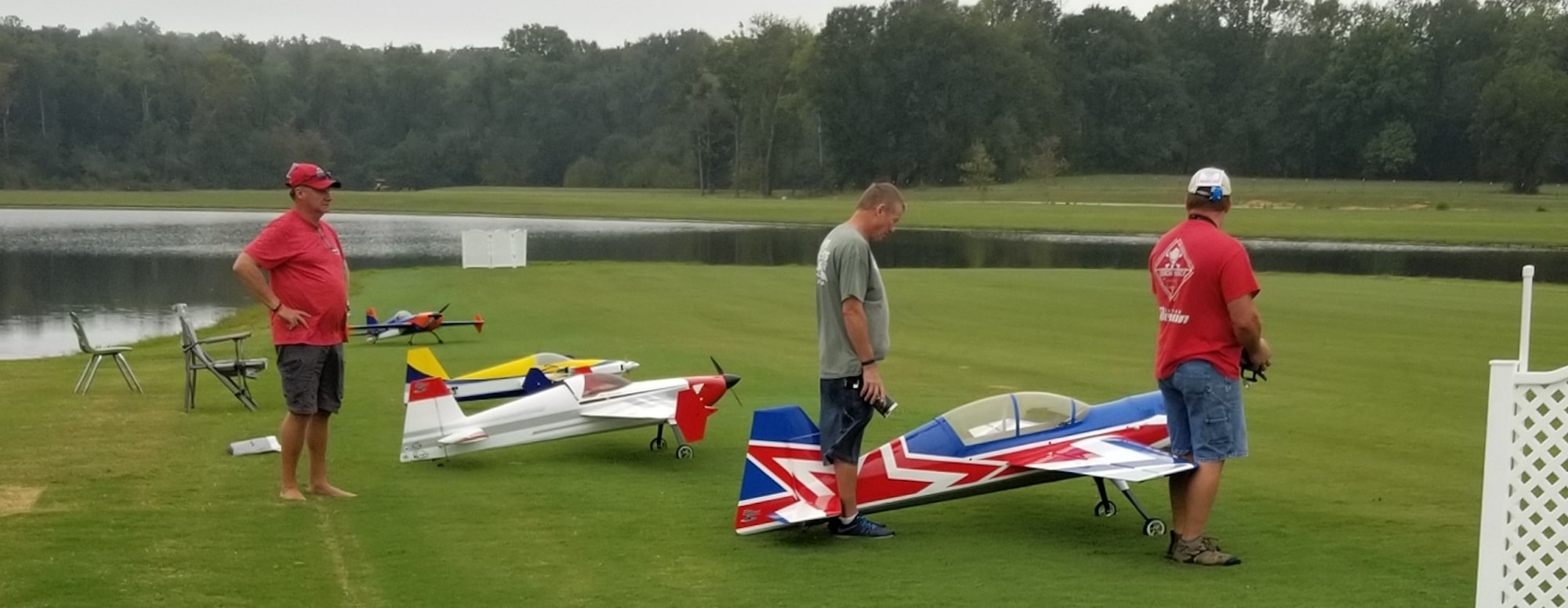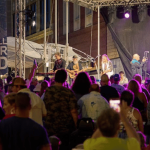Triple Tree Aerodrome
By Brad Wright, produced in cooperation with the HubCity Writers Project. Updated for accuracy in May 2019.
It’s a beautiful, early fall day as I make my way down Highway 221 to the Triple Tree Aerodrome near Woodruff. The sky is as clear as my expectations are hazy. I have never heard about this place in our community, yet it’s billed as the “Augusta National of Aviation.” I have no idea what I’m going to see, but I have a feeling it’s going to be interesting regardless.
Arriving at the main entrance, I begin a slow ascent to the visitor’s center at the top of a hill. My first impression is that this place is massive. The rolling hills and fields are currently home to hundreds of RVs and tents. In the sky I can see small, radio-controlled planes whizzing about, doing barrel rolls, loopdeeloops, and fantastic dives. At the visitor’s center I meet Rob Traynham, an incredibly genial volunteer who is one of the leaders at the Aerodrome.
 Rob drives me around the area and gives me a bit of history and information about the Triple Tree Aerodrome. Founded in 2000 by aviation enthusiast Pat Hartness, it and serves as a place of fun, fellowship and hospitality for those who enjoy the pursuit of flight. Some of the facts are staggering. With over 400 acres of land, the Aerodrome features a 7,000-foot grass runway, the longest in the world. To keep it in pristine condition the runway is mowed every 48 hours (which gave rise to the Augusta National comparison).
Rob drives me around the area and gives me a bit of history and information about the Triple Tree Aerodrome. Founded in 2000 by aviation enthusiast Pat Hartness, it and serves as a place of fun, fellowship and hospitality for those who enjoy the pursuit of flight. Some of the facts are staggering. With over 400 acres of land, the Aerodrome features a 7,000-foot grass runway, the longest in the world. To keep it in pristine condition the runway is mowed every 48 hours (which gave rise to the Augusta National comparison).
As a 501(c)(3) through their ACE (Aviation Centered Education) portfolio, this facility is run by only two permanent staff members and over 100 volunteers who all work together to maintain the property, organize events, provide outreach and mentoring opportunities through ACE, and maintain fiscal management of the globally recognized organization. They offer a variety of events throughout the year, including both general aviation and radio-control performances—though I must note that nearly all of the events are private, except for Young Aviators which takes place in June each year and is open to the public.
At their events with full-size aircraft there will be as many as 800 planes on the Aerodrome grounds. Their biggest radio-control event, Joe Nall Week (named for a former master of ceremonies at the fly-in), is the largest of its kind anywhere in the world.
 As we drive throughout the premises I am struck by the sheer number of people there, as well as the delight they all seem to share in flying their RC planes. There are countless groups of RVs huddled together, with their owners sitting in a circle together chatting. Rob stops at each one and asks them if they are enjoying themselves, and then invites them to the evening’s barbecue.
As we drive throughout the premises I am struck by the sheer number of people there, as well as the delight they all seem to share in flying their RC planes. There are countless groups of RVs huddled together, with their owners sitting in a circle together chatting. Rob stops at each one and asks them if they are enjoying themselves, and then invites them to the evening’s barbecue.
We pass a WWII-era flight control tower on our way to the main field for radio control flying. I am stunned both by the size and design of these planes. They are meticulously designed to resemble full- size aircraft as closely as possible, which allows them to perfectly mimic any maneuver those planes can perform. It is late in the afternoon and only a few people are still flying, but it is dizzying to watch the skill with which they command their radio-controlled planes. As I express wonder at their abilities Rob turns to me and says, “Do you want to try it?” I sheepishly demure, but he is insistent.
 Before I know it I am at the Hangar, a 10,000-square-foot building that houses several astonishingly beautiful and antique planes. Rob introduces me to another volunteer who is going to serve as my instructor. The training RC plane has dual controllers and several other features that they assure me will prevent me from crashing this thing. Once it is airborne my instructor tells me to do some turns and loops and even a barrel roll. I am surprised not at how easy it is, but how much fun it is. I am almost able to imagine what it would be like to be an actual pilot, and it is a thrilling idea. I keep it in the air for about ten minutes before my eyes start to hurt from the glare of the fading sun, and my instructor takes it over and brings it in for landing.
Before I know it I am at the Hangar, a 10,000-square-foot building that houses several astonishingly beautiful and antique planes. Rob introduces me to another volunteer who is going to serve as my instructor. The training RC plane has dual controllers and several other features that they assure me will prevent me from crashing this thing. Once it is airborne my instructor tells me to do some turns and loops and even a barrel roll. I am surprised not at how easy it is, but how much fun it is. I am almost able to imagine what it would be like to be an actual pilot, and it is a thrilling idea. I keep it in the air for about ten minutes before my eyes start to hurt from the glare of the fading sun, and my instructor takes it over and brings it in for landing.
Rob tries to get me to come to the barbecue, but unfortunately I have a previous engagement. Surprisingly, I was disappointed, as I had not expected to have such a good time. The Triple Tree Aerodrome is a hidden gem in Spartanburg County. To attend events at the Triple Tree Aerodrome, you will need a connection to an aviation organization, or a reservation if you’re with a school group—though they are working to expand venue rentals, which could give you another opportunity to visit the impressive facility. You’ll be hard pressed to find a more warm and welcoming place.
Contact Triple Tree via the website at tripletreeaerodrome.com
Brad Wright, Produced in cooperation with the HubCity Writers Project.
 Brad Wright is a Spartanburg native and freelance dilettante, recently returned to the Hub City after an extended tour of the Southeast. When he’s not entertaining his lab Rex Banner you can find him volunteering at Hub City Bookshop and the County History Museum. He loves to discuss pop culture ephemera, the Appalachian Trail and his recent appearance on Jeopardy!
Brad Wright is a Spartanburg native and freelance dilettante, recently returned to the Hub City after an extended tour of the Southeast. When he’s not entertaining his lab Rex Banner you can find him volunteering at Hub City Bookshop and the County History Museum. He loves to discuss pop culture ephemera, the Appalachian Trail and his recent appearance on Jeopardy!






